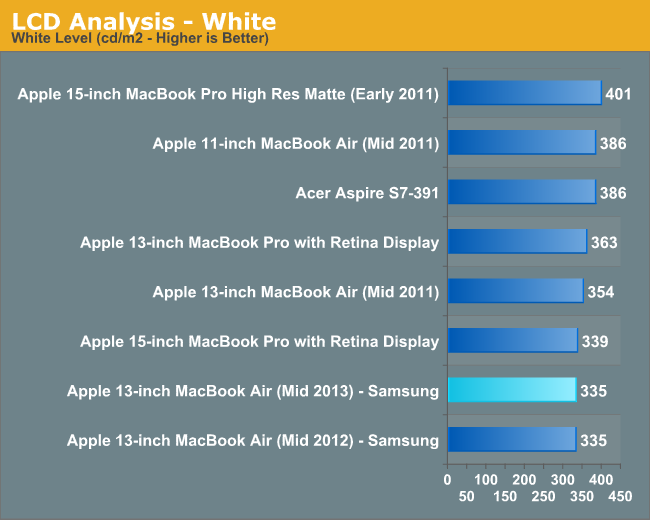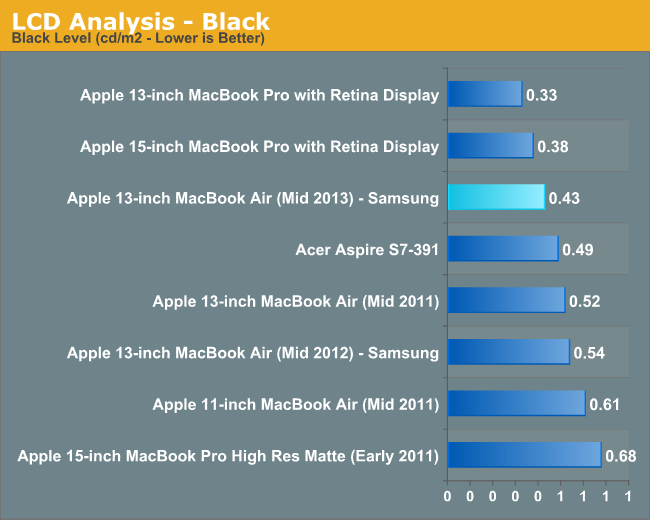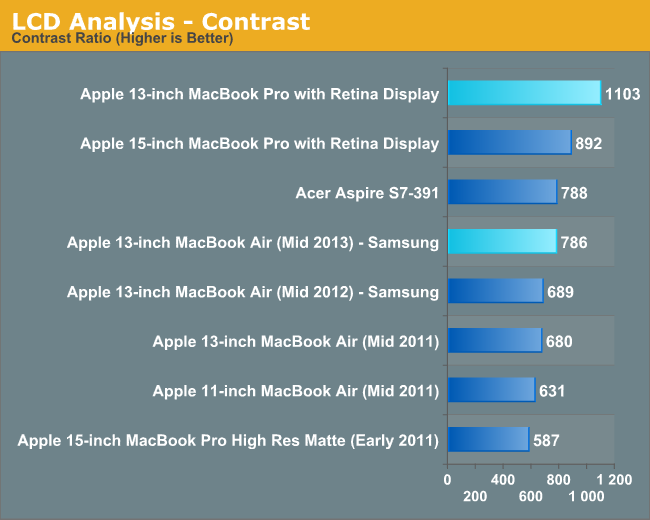The 2013 MacBook Air Review (13-inch)
by Anand Lal Shimpi on June 24, 2013 12:01 AM ESTDisplay
When I reviewed the 13-inch MacBook Pro with Retina Display, I viewed it as the true Retina MacBook Air that everyone was waiting for. With modest increases in thickness and weight, the rMBP13 gave you a much better screen and a larger battery to drive it. Apple’s lineup made sense.
After being in Taiwan earlier this month and checking out all of the 13.3-inch 2560 x 1440 displays being used on notebooks similar in size to the 13-inch MBA, I was beginning to reconsider my position.
To hit an aggressive schedule, you have to mitigate risk. In the case of the 2013 MBAs, Apple kept the chassis spec unchanged in order to do just that. As a result, the displays too, remained unchanged. We’re talking about TN panels (admittedly higher quality than most) and traditional pixel densities. Compared to the Retina Displays deployed across the rest of Apple’s product lines, these panels just aren’t as good. Compared to what you typically find elsewhere, they’re still among the best.

There are two aspects to deploying a Retina Display in a MacBook Air that are worth discussing. The first is power consumption. Greater pixel density requires a more powerful backlight to drive the panel at the same brightness, which in turn reduces battery life. Apple’s solution is to deploy Retina Displays on products it can outfit with a sufficiently large battery. I’d argue that given the battery life of the 2013 MBAs, Apple could move to a Retina Display and still deliver reasonable battery life - but it would be a regression.
The second thing to consider is price. I don’t know just how much more a Retina Display would add to the cost of a MacBook Air, but it’s clear it would be non-negligible.
There’s no real solution to the first problem, but the second one should be less of an issue as panel prices come down. I don’t know where Apple will eventually land on all of this, but today what happens is we get a well defined separation between MacBook Air and MacBook Pro with Retina Display.
Professional users who need greater color accuracy and/or additional desktop resolution really should go for the MacBook Pro with Retina Display. If you don’t need either, the MacBook Air will suffice.
In practice, the MBA’s display isn’t bad by any means. I’ve been staring at it non-stop since WWDC and don’t mind using it at all. The biggest visual issue for me is actually the shifting contrast at off-center vertical angles. It’s not a problem once you properly adjust the display angle but it’s something you don’t have to deal with on the rMBPs. When I'm not in crazy work mode, the lack of resolution isn't a huge deal - but when putting together big articles like this one, I find myself missing the rMBP quite a bit. I guess that's why the rMBP has Pro in the name.



My review sample featured a Samsung panel (LSN133BT01A02), although I’m sure the usual panel lottery is in full effect this generation as it has been in the past. Brightness and contrast are both comparable to what we had last generation (my Samsung panel this year was a bit better than last year's). The brightness/contrast results are very comparable to Acer's 1080p S7, just to show you how far Ultrabooks have come.
I ran the 2013 MBA through Chris Heinonen’s new display workflow using CalMAN to give you an idea of color accuracy vs. the rMBP:



| CalMAN Display Comparison | ||||||||
| Apple iPad (3rd gen) | Apple iPhone 5 | 13-inch rMBP (uncalibrated) | 13-inch 2013 MBA (uncalibrated) | Google Chromebook Pixel | ||||
| Grayscale 200 nits Avg dE2000 | 3.7333 | 3.564 | 1.7825 | 3.348 | 7.132 | |||
| CCT Avg (K) | 6857K | 6925K | 6632K | 6809K | 6442K | |||
| Saturation Sweep Avg dE2000 | 3.193 | 3.591 | 2.1663 | 5.3608 | 7.0927 | |||
| GMB Colorchecker Avg dE2000 | 3.0698 | 4.747 | 2.4521 | 3.9883 | 5.7664 | |||
The 13-inch MacBook Air isn’t bad, but Apple’s Retina Display is just better.













233 Comments
View All Comments
spronkey - Monday, June 24, 2013 - link
Hmm. Very interested to see the CPU and battery life numbers for the i7 upgrade. If it manages to increase performance by 10% or so, and decrease battery life 10% or so, it could be a nice sweet spot.Bkord123 - Tuesday, June 25, 2013 - link
I can't wait for the i7 review. I think it's the once I'm leaning toward getting.timmyj9 - Monday, June 24, 2013 - link
i would be curious to know if the same 802.11ac file sharing bottlenecks occur when using NFS as the file sharing protocol?Kevin G - Monday, June 24, 2013 - link
It would as the tweak to resolve it was made to TCP and modern NFS are built on top of that.Khato - Monday, June 24, 2013 - link
Can't agree more that Haswell battery life is already blurring the lines with current tablets. I'm curious how the 2013 Tablet Bench Web Browsing suite compares specifically to the one used on notebooks? In the details provided in this review the specific frequency of web page loading is specified while it's not in the Tablet version.The iPad 4 with it's 42.5Wh battery and 9.48 hours of run-time in the test draws an average of 4.48W. If that test is comparable to the Light version shown here then you have the Haswell Macbook Air drawing an average of 4.9W, while if it's comparable to the Medium version then the average is 6.05W. Either way, when you consider that the Macbook Air's 13.3" diagonal screen has 1.88x more surface area than the iPad 4 (nit is another term for cd/m^2, so total luminous intensity of a 13.3" screen at 200 nits is 1.88x that of a 9.7" screen at 200 nits) it's pretty much a given that display power for the Macbook Air is higher than for the iPad 4 despite the lower resolution. Pretty cool.
Shivansps - Monday, June 24, 2013 - link
The HD5000 is running on single channel right? there is a 2do slot for another memory?Kevin G - Monday, June 24, 2013 - link
The entire SoC has dual channel memory. The MacBook Air has no memory expansion slots. If you want to get one of these, be sure to order with the amount of memory you think you'd need in the future.Shivansps - Monday, June 24, 2013 - link
Im saying that because of the IGP performance, i cant find any confirmation on the review that the MBA is running on dual channel memory, 4GB LPDDR3 sounds like 64 bit single channel to me, and that will impact IGP performance, even HD3000 has reduced 3D performance if not running on dual channel.Glindon - Monday, June 24, 2013 - link
Every Macbook Air that I've owned ran in dual channel mode. Why would this year's be any different.Kevin G - Monday, June 24, 2013 - link
Note the part in this article referring to the LPDDR3. It indicates that it has four 32 bit LPDDR3 packages which indicate a 128 bit wide bus (dual channel).